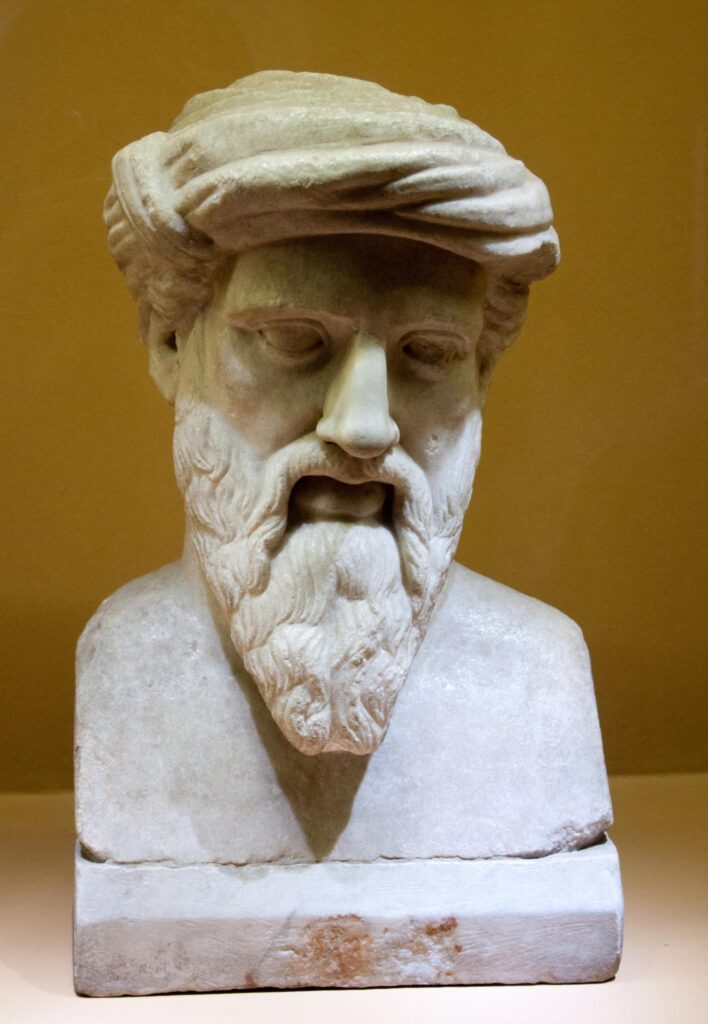In mathematics, a harmonic progression(H.P.) is a progression formed by taking the reciprocals of an arithmetic progression.
The sequence is a harmonic progression when each term is the harmonic mean of the neighboring terms.
It is an infinite sequence of the form
\(\displaystyle {\frac {1}{a}},\ {\frac {1}{a+d}}\ ,{\frac {1}{a+2d}}\ ,{\frac {1}{a+3d}}\ ,\cdots\)where ‘a’ is non zero and ‘−a/d‘ is not a natural number, or a finite sequence of the form
\(\displaystyle {\frac {1}{a}},\ {\frac {1}{a+d}}\ ,{\frac {1}{a+2d}}\ ,{\frac {1}{a+3d}}\ ,\cdots ,{\frac {1}{a+kd}} \)
where ‘a’ is non zero, ‘k’ is a natural number and ‘-a/d’ is not a natural number or is greater than ‘k’.
Index
History
The study of harmonic sequences dates to at least the 6th-century BCE when the Greek philosopher and mathematician Pythagoras and his followers sought to explain through numbers the nature of the universe. One of the areas in which numbers were applied by the Pythagoreans was the study of music.

The seventeenth-century witnessed the classification of series into specific forms. In 1671 James Gregory used the term infinite series in connection with the infinite sequence. It was only through the rigorous development of algebraic and set-theoretic tools that the concepts related to sequence and series could be formulated suitably.
Terms in a Harmonic Progression
A sequence \(\frac{1}{a}, \frac{1}{a_1}, \frac{1}{a_2}, \frac{1}{a_3},…, \frac{1}{a_n},… \) is called an arithmetic sequence or arithmetic progression.
Here,
\(\frac{1}{a}\) is the first term.
\(\frac{1}{a_1}\) is the second term,
\(a_1\) can be given by \(a_1 = a + d\), and by taking reciprocal we can get \(\frac{1}{a_1} = \frac{1}{a + d}\).
\(\frac{1}{a_2}\) is the third term,
with \(a_2 = a_1 + d\) and taking reciprocal of this gives us \(\frac{1}{a_1 + d}\)
‘d’ is the common difference between two consecutive terms and it remains the same throughout a particular series.
Here we can get the generalized formula for the arithmetic sequence as:
\(l = \frac{1}{a + (n-1)d}\).
Here, \(a \neq 0\)
Where,
‘l’ is the last term
‘n’ is the no. of term
‘a’ is the first term
‘d’ is the common difference
Sum of an Harmonic Progression
Infinite harmonic progressions are not summable.
A harmonic progression of distinct unit fractions (other than the trivial case where a = 1 and d = 0) can’t sum to an integer. The reason is that at least one denominator of the progression will be divisible by a prime number that does not divide any other denominator.
Application of a Harmonic Progression
Use in Geometry: If collinear points A, B, C, and D are such that D is the harmonic conjugate (the two points that divide a line segment internally and externally in the same ratio) of C with respect to A and B, then the distances from any one of these points to the three remaining points form a harmonic progression.
In a triangle, if the altitudes are in arithmetic progression, then the sides are in harmonic progression.
Leaning Tower of Lire: In the Leaning Tower of Lire, uniform blocks are stacked on top of each other to achieve the maximum sideways or lateral distance covered. The blocks are stacked 1/2, 1/4,1/6, 1/8, 1/10… distance sideways below the original block. This ensures that the center of gravity is just at the center of the structure so that it does not collapse. A slight increase in weight on the structure causes it to become unstable and fall.
Questions
Question 1. Find the 4th and 8th term of the series 6, 4, 3, …
Solution. By reciprocal, we can turn this H.P. to an A.P.
\(\frac{1}{6},\frac{1}{4},\frac{1}{3}, …\)
Here, \(a_2 – a_1 = a_3 – a_2 = \frac{1}{12}\)
Therefore, \(\frac{1}{6},\frac{1}{4},\frac{1}{3}\) are in A.P.
4th term of this A.P. = \(\frac{1}{6} + 3 *\frac{1}{21} = \frac{1}{6} + \frac{1}{4} = \frac{5}{12}\)
8th term = \(\frac{1}{6} + 7 * \frac{1}{12} = \frac{9}{12}\).
Hence the 8th term of the H.P. is \(\frac{12}{9} = \frac{4}{3}\)
and the 4th term is \(\frac{12}{5}\).
Question 2. If the sixth term of an H.P. is 10 and the 11th term is 18. Find the 16th term.
Solution.
Here, \(a_6 = a + 5d = \frac{1}{10}\)
And \( a_{11} = a + 10d = \frac{1}{18}\)
Therefore, \(\frac{1}{10} + 5d = \frac{1}{18}\)
=> \(d = \frac{-2}{225}\)
=> \(a = \frac{13}{90}\)
Hence, \(a_{16} = a + 15d\)
=> \(a_{16} = \frac{13}{90} – \frac{2}{15}\)
=> \(a_{16} = \frac{1}{90}\)
Hence, the 16th term will be 90.
FAQs
H.P. is \(\frac{1}{\mbox{A.P.}}\)
(OR) in simpler terms
if A.P. = a, b, c, d, e …
then, H.P. = \(\frac{1}{a}, \frac{1}{b}, \frac{1}{c}, \frac{1}{d}, \frac{1}{e} …\)
H.P. series when the reciprocals of elements are in A.P.
The general formula for calculating a harmonic mean is:
H.M. = \(\frac{n}{(\sum \frac{1}{x_i})}\),
where n is the no. of values and \(x_i\) is the term.
Its name comes from the concept of overtones, or harmonics in music: the wavelengths of the overtones of a vibrating string are 12, 13, 14, etc., of the string’s fundamental wavelength.
